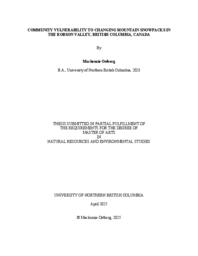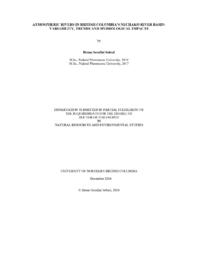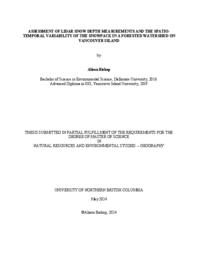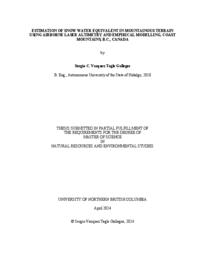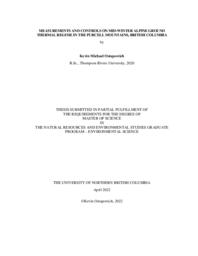Shea, Joseph
Person Preferred Name
Joseph Shea
Related Works
Content type
Digital Document
Origin Information
Content type
Digital Document
Origin Information
Content type
Digital Document
Origin Information
Content type
Digital Document
Origin Information
Content type
Digital Document
Origin Information
Content type
Digital Document
Origin Information
Content type
Digital Document
Description / Synopsis
This research aims to enhance scholarly understanding of snow dynamics, the remotely sensed snowpacks, and the calculation of basin-wide snow water equivalent in mountainous terrain. Mountain snow is a critical source of meltwater. However, forecasting snow distributions and total water equivalence in mountain basins is limited due to complex terrain, challenging environmental conditions, and lack of observations. Laser altimetry can provide detailed observations of snow depth, but an estimate of snow density is required to evaluate the total basin water equivalence. This study uses laser altimetry surveys and empirically modelled snow densities to estimate mountainous basin-wide snow-water equivalent (SWE). Between 2017 and 2020, seven laser altimeter surveys during late winter and spring were conducted in the LaJoie Basin, Coast Mountains, British Columbia (B.C.), a strategic hydroelectric power reservoir. The laser-derived snow depths averaged between 1.4 and 2.1 m for non-glacierized terrain, while glacierized terrain weighted averages ranged between 2.2 and 5.4 m. The laser-derived depths were combined with empirical snow density models to derive distributed SWE for the Lajoie Basin. Ten linear and three non-linear snow density empirical models were tested and developed, from which (a) a snow course multi-parameter, non-linear relation and (b) snow pillow robust (Huber loss) linear regressions yielded this study’s lowest root mean squared errors (51.65 and 74.12 kg m-3, respectively). For non-glacierized terrain, the multi-parameter, non-linear model produced basin-wide SWE averages between 0.56 and 1.06 m.w.e. and propagated uncertainties from ± 0.1 to ± 0.14 m.w.e. Conversely, glacierized terrain exhibited weighted SWE averages between 0.82 and 2.93 m.w.e., with estimates of uncertainty ranging from ± 0.31 to ± 0.52 m.w.e. The robust linear regressions yielded non-glacierized SWE averages from 0.49 to 0.92 m.w.e., with uncertainties between ± 0.14 and ± 0.2 m.w.e. The weighted SWE averages in glacierized terrain ranged between 0.77 and 1.92 m.w.e., with estimates of uncertainty between ± 0.29 and ± 0.45 m.w.e. The SWE estimates from lidar and modelled density are comparable to snow pillow observations at the watershed, which demonstrates the effectiveness of these coupled techniques and improves our forecasting capabilities.
Origin Information
Content type
Digital Document
Description / Synopsis
Wildfires are a growing threat due to climate change, and they often leave unburned forest patches called fire refugia. While young forests in some regions burn more severely, preliminary observations in central British Columbia suggest that managed juvenile forests exhibit lower fire severity, potentially influenced by fuel moisture conditions, and stand characteristics. To identify the role of fuel moisture in the formation of juvenile stand fire refugia, this research collects and examines groundbased, empirically modelled, and remote sensing indices of greenness, moisture, and fire severity. This thesis investigates the fuel moisture contents (FMC) of duff, fine woody debris, and foliage at six locations near Prince George and Smithers, British Columbia (BC), over two summers (2021 and 2022). A total of 6116 individual samples of foliage, fine woody debris, and duff were collected from open, juvenile, and mature conifer forest stands and analysed for moisture content (MC). On average, the MC of duff and fine woody debris samples was higher in juvenile and mature forests than open sites. In contrast, open forests had higher foliage MC than the other forests. Observations of FMC were used to evaluate the accuracy of FMC estimates extracted from the Canadian Forest Fire Weather Index (FWI) system. Observations of FMC were also compared with remote sensing indices to assess the utility of using spaceborne (Landsat 8&9, Sentinel 2) remote sensing to predict local FMC. Three versions of the FWI model were used to estimate FMC: the original FWI model which uses the closest fire weather station, and versions that used updated parameters based on local fuel conditions and in-stand weather data. When estimating fine woody debris MC, the best statistical results are obtained with locally calibrated models at open stands. However, the original FWI model provides better estimates of duff MC in juvenile stands. For remote sensing of foliar MC in juvenile stands, the Normalized Difference Moisture Index (NDMI) had a higher R2 value (0.334) and a lower RMSE than other indices, while the NDMI gave the best result for foliar MC in mature forests (R2 = 0.160). For fine woody debris and duff MC in open stands, none of the remote sensing indices tested have R2 > 0.1 when estimating duff and fine woody debris MC. However, the RMSE of using empirical models from FWI to estimate duff (lowest at 59.95% RMSE) and fine woody debris (21.13%) MC was higher than remote sensing (41.64% for duff, 17.50% for fine woody debris). Remote sensing indices such as NDMI and GNDVI (Green Normalized Difference Vegetation Index) were used to estimate pre-burn FMC, and the estimated FMC results were found to be generally higher at juvenile stands than mature forest from a case study area from Plateau Complex Wildfire of 2017. Lower remote sensing estimates of FMC in mature stands corresponded to higher burn severities.
Origin Information
Content type
Digital Document
Description / Synopsis
Alpine snow is an important water reservoir for mountain hydrology, climate, ecosystem functions, and has substantial economic value. Snowmelt during spring and summer is driven primarily by incoming shortwave and longwave radiation fluxes, and the ground heat flux is considered to be negligible during this time. However, during the accumulation phase, the ground heat flux may contribute to snowpack thermal conditions and midwinter melt, though this subject has not been studied extensively. The objective of this study is to quantify the alpine ground thermal regime and its relation to topographic setting and the overlying snowpack. The effects of elevation, maximum winter snow depth, snow cover duration, slope, ruggedness, aspect, total potential solar radiation, proximity to glacial ice, and depth of thermistor were evaluated. Four transects consisting of 29 temperature data loggers at the ground-snow interface and one meteorological station collected data from 16 August 2020 to 6 August 2021 at an alpine site in the Purcell Mountains in British Columbia. Snow cover duration, onset, and end-of-winter depths were found to have the greatest influence on the ground thermal regime. Total potential solar radiation had an inverted relation with ground temperatures, however, this was likely related to snow cover duration. Modeled ground heat flux scenarios revealed that snow depth or onset is the most influential of the variables tested. Snow thermal conductivity has the second greatest influence on total ground heat flux, however, true snow thermal conductivity likely varies throughout the winter season and was not measured in this study. Wind has the greatest influence on snow distribution within the Conrad basin with wind scoured slopes coincidentally sharing the same aspect as slopes that receive the greatest total potential solar radiation. There is little evidence to suggest that the ground thermal regime has any influence over the overlying snowpack.
Origin Information



